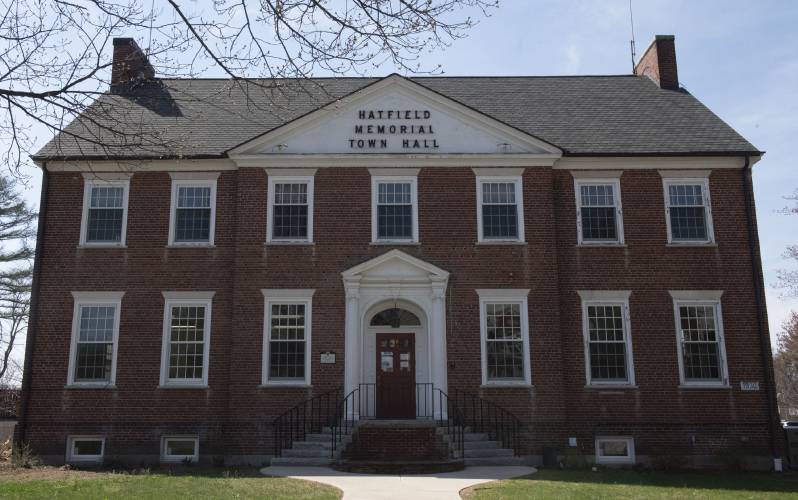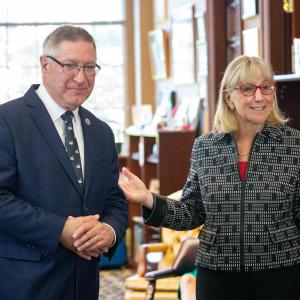Housing among topics under review as Hatfield updates its comprehensive plan

Hatfield Town Hall 04-14-2023 —
| Published: 02-10-2024 5:51 PM |
HATFIELD — Building more affordable and workforce housing, protecting farmland and making the town more resilient to flooding are among areas that could be prioritized as Hatfield undertakes a review of current town rules and regulations as part of its comprehensive plan.
With the Pioneer Valley Planning Commission providing 125 hours of assistance to Hatfield, Patty Gambarini, PVPC’s chief environmental planner, informed the Planning Board this week that five areas are the focus: housing, health and environment — with an emphasis on healthy aging in place — stormwater management, flood resilience and farmland protection.
PVPC representatives have already been meeting regularly with the Comprehensive Plan Committee, which is undertaking the “Hatfield 2040: A Vision to Protect, Prepare and Prosper” using a $283,900 state Municipal Vulnerability Preparedness Action Grant. PVPC’s work is to consider regulations already on the books and make suggestions for improvements, Gambarini said.
With respect to housing, Select Board member Ed Jaworksi said that officials regularly get comments from families with grown children who would like to have them return to town, but find there is no place to rent or buy, and restrictive zoning prevents potential development.
Planning Board member David Leon Bell Jr. said planners are cognizant that Hatfield has limited affordable and moderate housing and is losing school age population. “It has everything to do with the prosperity of the town,” Bell said.
To that end, Kyle Finnell, a senior planner at PVPC said, a handful of recommendations are coming. One is expanding accessory dwellings and have voters consider allowing detached accessory dwellings. A second is to increase residential density, either with a Chapter 40R smart growth zoning district or a Chapter 40Y family starter home zoning district. A third is to establish relationships with local housing nonprofits to bring more units to the community, possibly associated with also establishing a municipal public housing trust fund.
Finnell said affordable housing was identified as an issue in the town’s 2015 housing production plan, yet single-family building has been essentially all of the development since then, the subsidized housing rate is under 4%, and about 24% of homeowner households and 14% of renter households are cost burdened, meaning they are spending 30% or more of income on housing costs.
Tying in to this, Becky Basch, PVPC’s senior planner for land use & environment, has engaged older adults in Hatfield with their concerns about aging place. A concern is the need to ensure sidewalks are available and connected to new subdivisions, and are accessible when passing over driveways.
Article continues after...
Yesterday's Most Read Articles
The final elements of the preliminary review of town codes is making sure Hatfield is more resilient to flooding. When housing developments and other projects are permitted, regulations may need to be changed to constrain impervious surface to mitigate local flooding and protect against summer heat. Gambarini said a checklist could be offered for low-impact development, perhaps during the presubmission review or preliminary plan for subdivisions.
Gambarini said the town currently has little specifics on erosion or sediment control in its rules, but could apply Massachusetts stormwater standards to upland areas.
Because the town is of part of the national flood insurance program, it has already adopted a floodplain overlay district and bylaw. But this needs to be updated, with maps more than 45 years old. Gambarini said using old maps to define where the flood plain is a problem, since 500-year floods are now 100-year floods.
“I think looking at the flood plain is a really good thing to tackle,” Gambarini said.
“You could be really much more restrictive, rather than allowing stuff under special permit,” Gambarini said.
Planning Board member Doug Finn said because refining the flood plains could significantly limit development, including in town center, it will require a lot of public conversations. “Some people really understand that this is isn’t invented this isn’t scare tactics, this is real facts,” Finn said.
Gambarini also suggested exploring both a farmland preservation overlay district, like in Amherst, and modifying the town’s transfer of development rights, which Hadley and Easthampton also use.
“Hadley is making it work because they’re offering huge incentives to developers there that end up developing on Route 9 and allows the town to protect farmlands outside of that Route 9 corridor,” Gamabrani said.
Bell, though, wasn’t sure that, with Hatfield’s proximity to Interstate 91, there could be congestion created on Routes 5 and 10, and that modeling zoning changes after Amherst or Hadley might be tough to sell. “If you picked the brain of a lot of people from Hatfield, they’d cringe at the thought of this town becoming anything like either of those towns,” Bell said.
Planning Board Vice Chairman James Tarr appreciated the preliminary work done by PVPC.
“I think you guys have done a wonderful job in giving us some information and some ideas of where to go and where we need to go and what we need to get away from,” Tarr said.
Scott Merzbach can be reached at smerzbach@gazettenet.com.

 State Senate budget funds free community college for all
State Senate budget funds free community college for all ‘We can just be who we are’: Thousands show support for LGBTQ community at Hampshire Pride
‘We can just be who we are’: Thousands show support for LGBTQ community at Hampshire Pride Doors open at Tilton Library’s temporary home at South Deerfield Congregational Church
Doors open at Tilton Library’s temporary home at South Deerfield Congregational Church Area property deed transfers, May 2
Area property deed transfers, May 2
